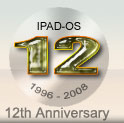
A: The IPAD, also known as the Internet Protocol Adapter, is a device based on the IPAD-OS which is a very specialized embedded operating system created by Philip L. Becker back in 1993. The specialized nature of the operating system allows it to be absolutely secure and very efficient with minimal hardware resources. This is similar, in concept, to the IOS used on most Cisco equipment in that it is first and foremost a high performance router. Other functions may be enabled in the IPAD-OS allowing it to be an intelligent firewall, Internet server (email, web, ftp, etc.) and terminal (modem) connectivity device as needed.
A: The IPAD project started in 1993 when Phil Becker saw that the
Internet (which first opened to commercial traffic in 1991) was fast
becoming a game that only large corporations were allowed to join. His
vision was a simple device with easy configurations that allowed an
average person to not only connect to the Internet, but have the same
power and ability the much larger corporations enjoyed. In August 1993 the
first Becker Box
was demonstrated at the ONE BBSCON
(later to become ONE ISPCON) and the reaction was very positive and
enthusiastic. It took two more years of dedicated development and field
testing to fully realize the IPAD as a commercial product. The first units
shipped late in 1995 and allowed small ISP businesses to appear almost
overnight.
A: The original 1995 eSoft IPAD was based on an Intel 486 chip housed in a mini-tower chassis and had no model number identifier. Later a rack mount Pentium version was introduced that was labeled Model 5000. To differentiate the two models, the original mini-tower was given a verbal Model 4500 designation by the eSoft sales force even though this was never an official model number. These two platforms ran exactly the same operating system software and are identical in every way except physical case.
The software was designed to be very flexible with an almost infinite combination of interface and control options. The system was free-form in that it could be totally tailored to the needs of each unique user. A maximum combination of 5 packet interfaces (Ethernet, Token Ring, etc.) and up to 96 serial ports (with optional line count expansion) are supported on each Model 5000.
The Model 2500, introduced in 1997, was created on a slim-line Pentium platform with a list of pre-configured hardware interfaces and limited configuration options. It was designed and targeted towards customers one level below the ISP which either lacked the technical ability or human resources to build and maintain traditional Internet connectivity solutions. One of the big features of this model was the self-healing subsystem which would detect and repair missing or corrupted system files. A maximum of 3 packet interfaces (Ethernet, Token Ring, etc.) and up to 8 serial ports are supported on each model 2500.
The last official eSoft IPAD model to be added was the 1200 in 1998. This was created to target customers which could not justify the price point of the model 2500. The major difference is the interfaces choices. A maximum of two packet interfaces (Ethernet only) and two serial interfaces are supported. Token Ring is not supported on the model 1200.
A: New development on the IPAD-OS unofficially ended in 1998. The IPAD family was officially dropped from the eSoft product line in January 2000. By February 2000 the IPAD Owners Association, Inc. (IOA) formed and started negotiations with eSoft to license the IPAD source code and development rights.
The IOA was able to license the rights to nearly all of the IPAD production and documentation information along with the IPAD operating system itself. The IOA has been releasing bug fixes and features upgrades for the IPAD ever since.